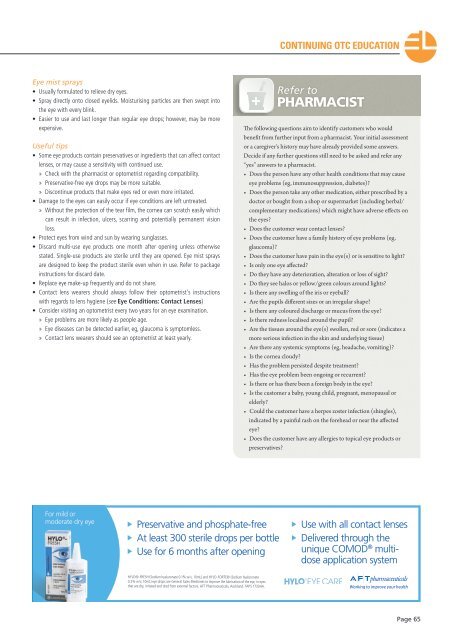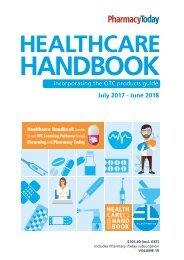2017 HCHB_digital
Create successful ePaper yourself
Turn your PDF publications into a flip-book with our unique Google optimized e-Paper software.
CONTINUING OTC EDUCATION<br />
Eye mist sprays<br />
• Usually formulated to relieve dry eyes.<br />
• Spray directly onto closed eyelids. Moisturising particles are then swept into<br />
the eye with every blink.<br />
• Easier to use and last longer than regular eye drops; however, may be more<br />
expensive.<br />
Useful tips<br />
• Some eye products contain preservatives or ingredients that can affect contact<br />
lenses, or may cause a sensitivity with continued use.<br />
»»<br />
Check with the pharmacist or optometrist regarding compatibility.<br />
»»<br />
Preservative-free eye drops may be more suitable.<br />
»»<br />
Discontinue products that make eyes red or even more irritated.<br />
• Damage to the eyes can easily occur if eye conditions are left untreated.<br />
»»<br />
Without the protection of the tear film, the cornea can scratch easily which<br />
can result in infection, ulcers, scarring and potentially permanent vision<br />
loss.<br />
• Protect eyes from wind and sun by wearing sunglasses.<br />
• Discard multi-use eye products one month after opening unless otherwise<br />
stated. Single-use products are sterile until they are opened. Eye mist sprays<br />
are designed to keep the product sterile even when in use. Refer to package<br />
instructions for discard date.<br />
• Replace eye make-up frequently and do not share.<br />
• Contact lens wearers should always follow their optometrist's instructions<br />
with regards to lens hygiene (see Eye Conditions: Contact Lenses)<br />
• Consider visiting an optometrist every two years for an eye examination.<br />
»»<br />
Eye problems are more likely as people age.<br />
»»<br />
Eye diseases can be detected earlier, eg, glaucoma is symptomless.<br />
»»<br />
Contact lens wearers should see an optometrist at least yearly.<br />
Refer to<br />
PHARMACIST<br />
The following questions aim to identify customers who would<br />
benefit from further input from a pharmacist. Your initial assessment<br />
or a caregiver's history may have already provided some answers.<br />
Decide if any further questions still need to be asked and refer any<br />
“yes” answers to a pharmacist.<br />
• Does the person have any other health conditions that may cause<br />
eye problems (eg, immunosuppression, diabetes)?<br />
• Does the person take any other medication, either prescribed by a<br />
doctor or bought from a shop or supermarket (including herbal/<br />
complementary medications) which might have adverse effects on<br />
the eyes?<br />
• Does the customer wear contact lenses?<br />
• Does the customer have a family history of eye problems (eg,<br />
glaucoma)?<br />
• Does the customer have pain in the eye(s) or is sensitive to light?<br />
• Is only one eye affected?<br />
• Do they have any deterioration, alteration or loss of sight?<br />
• Do they see halos or yellow/green colours around lights?<br />
• Is there any swelling of the iris or eyeball?<br />
• Are the pupils different sizes or an irregular shape?<br />
• Is there any coloured discharge or mucus from the eye?<br />
• Is there redness localised around the pupil?<br />
• Are the tissues around the eye(s) swollen, red or sore (indicates a<br />
more serious infection in the skin and underlying tissue)<br />
• Are there any systemic symptoms (eg, headache, vomiting)?<br />
• Is the cornea cloudy?<br />
• Has the problem persisted despite treatment?<br />
• Has the eye problem been ongoing or recurrent?<br />
• Is there or has there been a foreign body in the eye?<br />
• Is the customer a baby, young child, pregnant, menopausal or<br />
elderly?<br />
• Could the customer have a herpes zoster infection (shingles),<br />
indicated by a painful rash on the forehead or near the affected<br />
eye?<br />
• Does the customer have any allergies to topical eye products or<br />
preservatives?<br />
For mild or<br />
moderate dry eye<br />
Preservative and phosphate-free<br />
At least 300 sterile drops per bottle<br />
Use for 6 months after opening<br />
Use with all contact lenses<br />
Delivered through the<br />
unique COMOD ® multidose<br />
application system<br />
HYLO®-FRESH (Sodium hyaluronate 0.1% w/v, 10mL) and HYLO-FORTE® (Sodium hyaluronate<br />
0.2% w/v, 10mL) eye drops are General Sales Medicines to improve the lubrication of the eye, in eyes<br />
that are dry, irritated and tired from external factors. AFT Pharmaceuticals, Auckland. TAPS 1733HA.<br />
Page 65



